Claire worked and wrote for Sight Seeker’s Delight for 7 years – read more here.
A complete A-Z guide on how to wow your guests with a perfect French meal
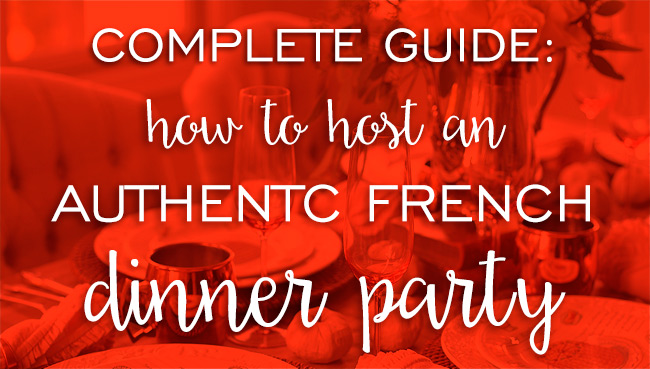
Do you want to add a French touch to your holiday meals this year?
The French can through some pretty epic dinner parties. Chic settings, great food, quality time and conversation… they seem to have it all just right.
Let’s take a thorough look into their process, from start to finish, so you can replicate it for your own French-themed dinner party!
From the food choices (and the order), to preparing it all, to wine, to table settings… we’ve got you covered in this complete guide.
Contents
- THE FOOD
- Aperitif & amuse-bouches
- Entrée
- Plat principal (and side dishes)
- Cheese
- Dessert
- Coffee
- THE PREPARATION
- Making sure your menu is doable for you
- Get help with the food
- Portion size notes
- Bread
- Wine pairing notes
- THE AMBIANCE
- Table setting
- Music
- Other drinks
- Aperitif & amuse-bouches
- Entrée
- Plat principal (and side dishes)
- Cheese
- Dessert
- Coffee
- Making sure your menu is doable for you
- Get help with the food
- Portion size notes
- Bread
- Wine pairing notes
- Table setting
- Music
- Other drinks
.
THE FOOD
Traditional French meals last for hours – partially because the French eat slowly, partially because there are so many courses. Rather than a North American family-style deal where all the food is put out on the table at once, the French take things one by one.
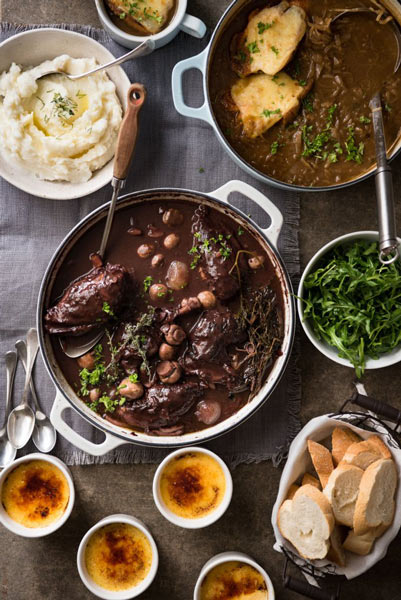
Image: recipetineats.com
Figure out how many courses you want to offer, and what you want to do for each one. Each course is described below. You’ll also see examples and recipes, as well!
.
Apéritif & amuse-bouche
The apéritif (or apéro for short) is so French that there’s really not a direct translation of the idea. An apéro is typically a drink plus a light snack, typically earlier on in the evening before dinner. Typically this part of a French dinner will not start at the table, but instead in the ‘salon’. For you, this could mean beginning in your big open kitchen or your living room.
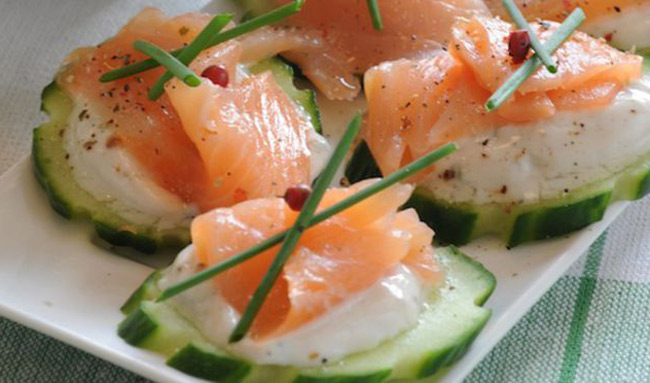
Image: cuisineactuelle.fr
An aperitif is not just a snack, it’s not just a drink… it’s the whole feel of the thing. To mix things up even more, there’s a double meaning to it as well! Any pre-meal drink that’s designed to whet your appetite is called an aperitif.
The direct translation of amuse-bouche is fun mouth, so that’s exactly what you’re going for here. Make mouths have fun! Amuse-bouche typically are tiny pre-appetizer snacks that can be eaten in one or two bites. They’re designed to be served prior to a meal, with a drink, to prepare everyone for what’s to come.
So here, you’ll be choosing a drink to go along with your amuse-bouche. Note that this doesn’t mean wine!

Image: eatsmarter.de
At some of my first true French meals, we drank diluted Ouzo, which is similar in flavor to Pastis (the French national drink). Champagne or wine is a classic French choice here, but you can get creative with other drinks for whetting the appetite.
Apéritif drinks
- Champagne
- Pastis (anise/black licorice)
- Kir/ Kir Royal
- Lillet
- Aperol/Aperol spritz (an Italian bitter spirit, but the French love it)
- Martini blanc or rouge (fortified wine)
Amuse-bouches
- Olives (feel free to get fancy with them too)
- Cured hams (here’s a guide)
- Lemon-Parsley Gougeres
- Cucumber Cups with Vichyssoise
- Cucumber and Smoked Salmon Sandwiches
- Provincial olive tapenade
- Mini tartes flambées
- Fromage fort dip
- Zucchini-tomato verrines
- Mini croque monsieurs
Dipping is a pretty newfangled idea in France. It’s a bit at odds with the refinement of a French dining experience. That’s why if a spread is offered (like the tapenade or fromage fort above), it will usually be spread on top of a small piece of bread or thin toast.
.
Entrée
Now that your guests have whetted their appetites on the aperitif, it’s time to move “à table”! Show your guests into the dining room and let them know this is where the real magic will happen. This is usually a simple dish, and many French make their lives easier by buying this course at a store. There are so many delicious prepared foods in Paris, it would be silly to not take advantage of them, don’t you agree?
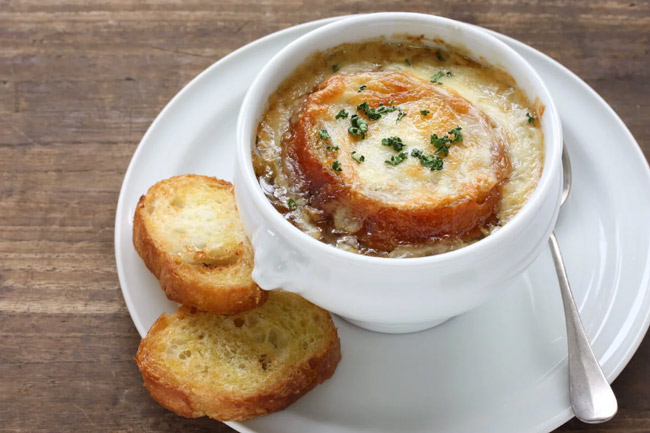
Image: French onion soup
In North America, many large grocery stores have fresh prepared sections with tasty dishes that will do the trick. See the ‘Consider help” section below for more details.
Entrées
- Delicious French onion soup
- Brandade de morue
- Foie gras
- Sea scallops
- Oysters, fresh or gratin
- Escargot
- Quiche (Lorraine, or vegetarian)
- Duck Pate
- Goat cheese tarts
.
Plat principal
Now we’re getting to the real heart of the meal.
In France, often this is the only course the host will cook (they’ll get the rest from ‘trateur’ caterers, their butcher shop or bakery, or a gourmet frozen food store like Picard).
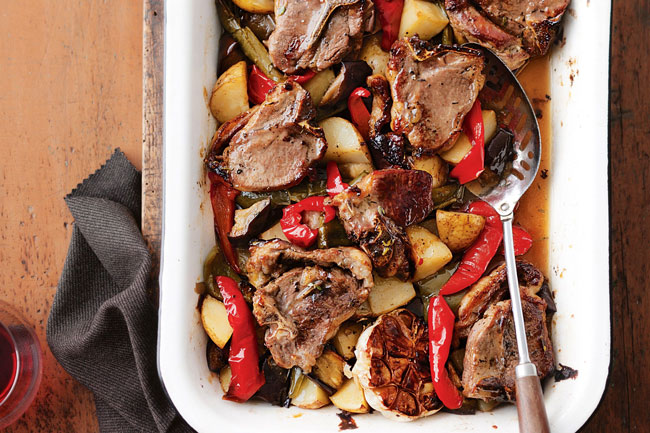
Image: taste.com.au
See below for some examples of classic French main dish options, and of course some side dishes as well!
It’s up to you if you decide to ‘plate’ the food before bringing it out (as they would in a restaurant), or if you have things family-style on the table. If it is family-style, the host typically serves everyone at the table (instead of each serving him- or herself).
And don’t forget the bread. A few crispy French baguettes and everyone is happy. See the section on bread below.
French main dishs
- Blanquette de Veau (French winter stew)
- Tartiflette (classic winter dish)
- Duck breast
- Hachis Parmentier (similar to Shepards Pie)
- Lamb roast
- Sole Meunière (white fish)
- Boeuf Bourgignon (French beef stew)
- Roasted garlic chicken
- Ratatouille
- Basque chicken stew
- Coq au vin
Pair your sides appropriately. You wouldn’t serve roasted vegetables as a side of a stew for example, since the stew is filled with veggies. In the same grain, don’t serve roasted potatoes with a Hachis parmentier or Tartiflette (which already have potatoes!).
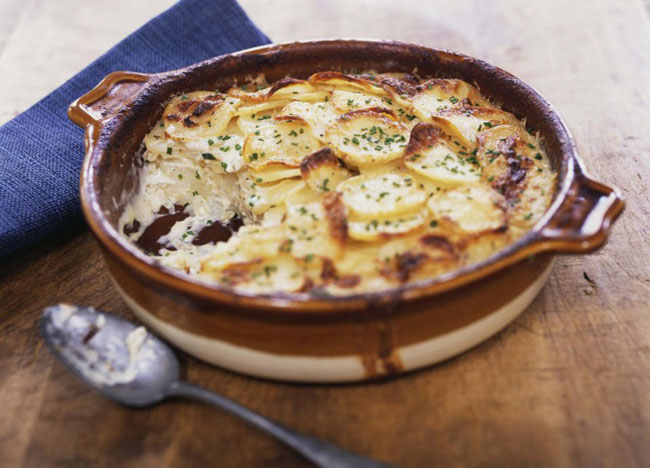
Image: thespruce.com
A simple fresh salad is always a good option. It’s part of the large majority of French meals.
Again, it’s important to remember that after the main dish you still have a cheese course and a dessert course!
French side dishes
- Simple French Bistro salad
- French scalloped potatoes
- Roasted vegetables
- Roasted potatoes
- French Aligot (amazing mashed potatoes)
- Mushrooms Provençal
- Asparagus (a few different options!)
- French country peas
.
Cheese
This is key! France isn’t famous for its cheeses for no reason, people!
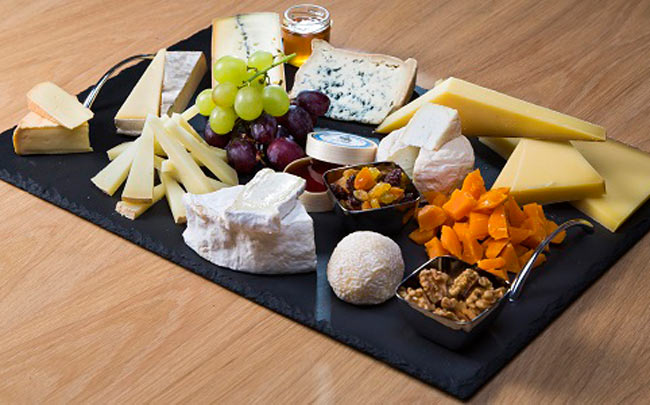
Image: lacaveaterroirs.fr
The average French person eat about 60 pounds (26.8 kilos) of cheese per year. Compare that to the whole European Union average (40.5 pounds or 18.3 kilos), the United States (35 pounds or 16 kilos), Australia (29.5 pounds or 13.5 kilos), or Canada (27.5 pounds or 12.5 kilos).
Wow, am I right?
A meal without cheese is like a day without sunshine – French proverb
Okay, if you live outside of France you’re not going to be able to find all the French cheeses your heart desires. And if you live in the US, you certainly won’t be able to find any raw cheese ones: they’re illegal there. But here are some important tidbits for you to know when creating the perfect cheese platter.
When to serve: It’s important to point out first though, that cheese is not served as a starter in France. If you want to do this right, it’s at the end of the meal right before dessert!
How many cheeses: Ideally to make a great cheese plate, you want an odd number of cheeses – this is a rule directly from our friends at Androuet, one of the oldest cheese shops in Paris. It’s just for aesthetic purposes, but if you want to be legitimate about this French meal, 3 or 5 different cheeses is a great option.
Which cheeses: When composing your cheese platter, the goal is to create a mix of different textures and flavors. Hard vs soft cheeses, mild vs strong, dry vs creamy.
You could start with a soft ripened cheese (like Brie or the stronger Camembert). Follow up with a creamy goat cheese like a Crottin de Chavignol or Tomme de chèvre (not all goat cheeses are dry, people!). Then try a hard cheese like Gruyere or Comté (both of these cheeses are better the longer they’re aged) or a hard sheep milk cheese (Ossau-Iraty is pretty common and delicious in France). I’d recommend a very soft cheese like Saint-Marcellin or Brillat-Savarin on your cheese board, if you can find it. Finish with the strongest: a blue cheese like Roquefort or Forme d’Ambert.
Cutting the cheese: There is a method to the madness! For round cheeses like camembert or crottin de chevre, go for wedges. Large slices from huge wheels of hard cheese (such as gruyere, comté) should be sliced into strips parallel to the rind. Check the image below for more cheese-cutting help.
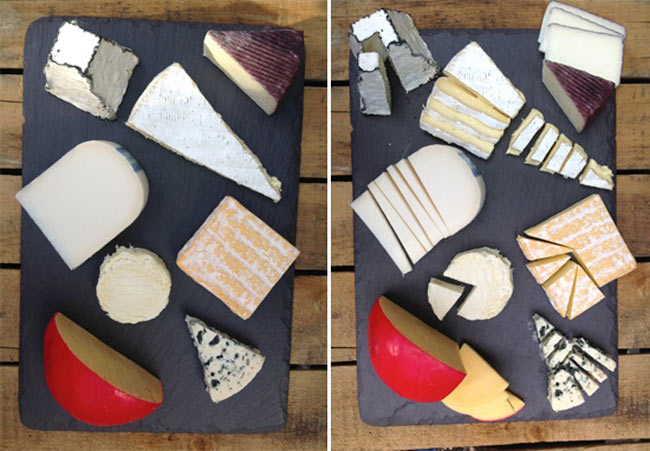
Image: Cutting French cheese
Butter on the board: Did you ever wonder why there’s always butter served on a cheese board in Paris? It’s to soften the sharpness of strong cheeses like Roquefort! You combine a bit of butter and a bit of the cheese on your piece of bread. It’s delicious… as you can imagine. Plus it’s a great way to get those who “don’t like blue cheese” to give it another try.
Add-ons: It’s a nice touch to sprinkle some nuts (like walnuts) and/or grapes on the platter. Some French cheese plates are also served with a sweet jam or jelly – another fabulous way to complement stronger or goat cheeses. Fig and quince are popular choices to be combined with cheese.
Timing: Take the cheese out of the fridge about 45 minutes to an hour before serving. You’ll lose a lot of flavor and texture (especially for soft cheeses) if they’re too cold!
.
Dessert
This is often bought from the local bakery/pastry shop. French bakeries are so wonderful, how can you resist? It also cuts down on the work you have to do to prepare the meal.
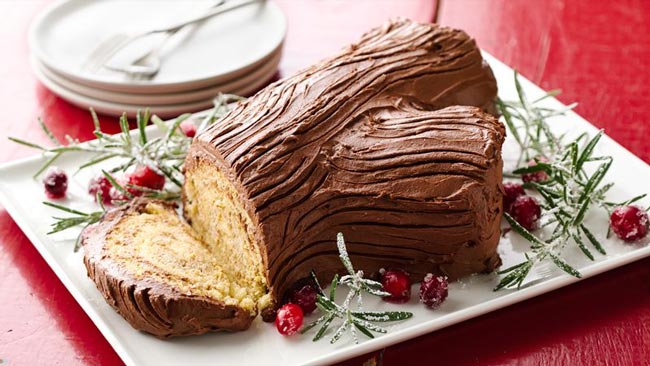
Image: bettycrocker.com
If you’re not in France, head to your favorite bakery or cake shop to see what they offer that might delight your guests.
Do you need inspiration on some true classics you might be able to pick up from a bakery? Or will you be tackling dessert yourself? See the list below (and wipe up that drool!)
French desserts
- Buche de Noel (traditional Yule log cake)
- Chocolate mousse (with only 3 ingredients!)
- Candied chestnuts (holiday specialty)
- Melting choco-caramel minicake
- Tarte tatin (upside-down apple pie)
- Creme brulée
- Opera (chocolate cake)
- Cherry Clafoutis (custard cake)
- Apple-Calvados bake
- Ile Flottante (meringue in vanilla cream)
- Poires Belle-Helène (poached pears)
- Crème au caramel (similar to flan)
- Deconstructed fruit tarts
.
Coffee
The French tend to drink un café after meals. This is a great opportunity for your guests to stretch their legs and help digesting your wondrous meal. It can be served right at the table, or in the salon or open kitchen.
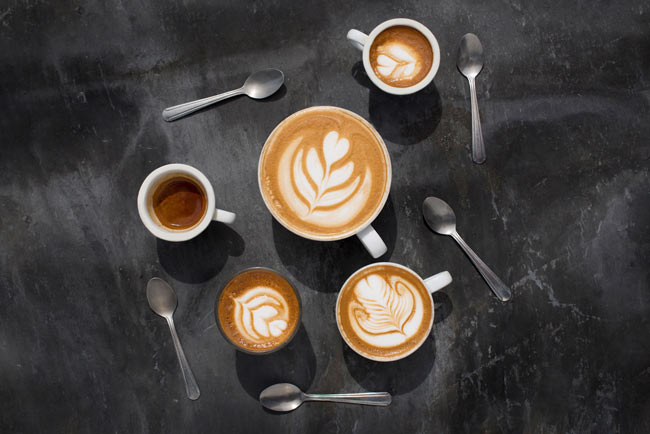
Image: espressoamano.com
This is the easiest of all the courses… just put on a pot of coffee! If you want to fancy it up a bit you can open a box of chocolates, but it’s not necessary.
.
THE PREPARATION
Make sure your menu is doable for you
Arguably the biggest part of a French meal is the company, not the food. Surprising, I know!
However meals really are more about quality time spent together. If you’re in the kitchen the entire time preparing food, that’s really going to put a damper on the experience (for you and your guests).
Here are a few tips to help out
- Consider help with the food (see below). Translation: not every course has to be made in your kitchen!
- Pre-prepare as much as you can. Can your vinaigrette be whipped up and put in a bowl in the fridge? Can your potatoes be cut, washed, seasoned, and put in the pan before dinner even begins?
- Timing is everything. Be aware of when your pre-prepared dishes should be popped into the oven. You don’t want your side dish to be ready 45 minutes before its accompanying main dish!
- Roasts, simmered, or just-throw-in-the-oven dishes are key. This way there’s nothing to really prepare when your guests are there – you just have to get the heat going!
.
Get help with the food
This is a must for most French hosts. Many will go to a traiteur which is like a caterer. They’ll pick up art of the meal – usually appetizers, side dishes, and/or desserts – so they don’t have to cook all the courses from start to finish.
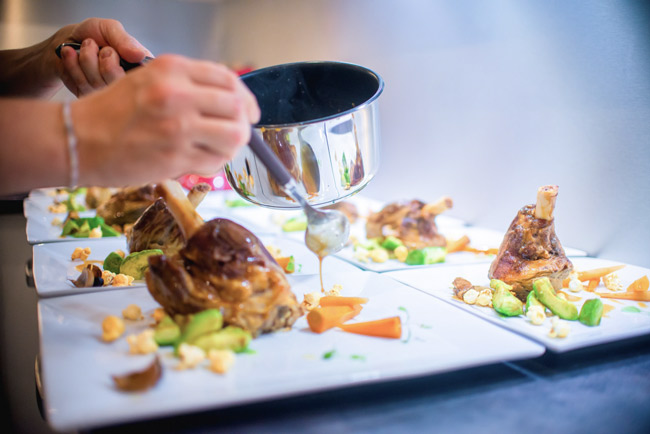
Image: i.pinimg.com
Though you may not find French favorites like celeri remulade or lentil salad at the fresh food counter of your North American grocery store, grab what you think your guests will appreciate! For your own sanity…
And know this: the French are not above frozen help, either. Picard is a popular up-scale frozen food store and many dinner parties wouldn’t be the same without Picard’s help! Regular grocery stores often have nice frozen appetizer, sides, and dessert options as well. Your grocery store likely has the same. A specialty or natural food store like Trader Joe’s or Whole Foods might have more interesting options here.
Sidenote: I’m not condoning mini frozen corndogs for your French meal, people… Corndogs have a time and a place but it’s not here! Try a Trader Joe’s or a Whole Foods for a few nice tidbits.
.
Portion sizes
Smaller portions are a huge difference between some other cultures and French meals. French meals are taken quite slow (again, the emphasis is on the moment and spending quality time, not gorging on food).
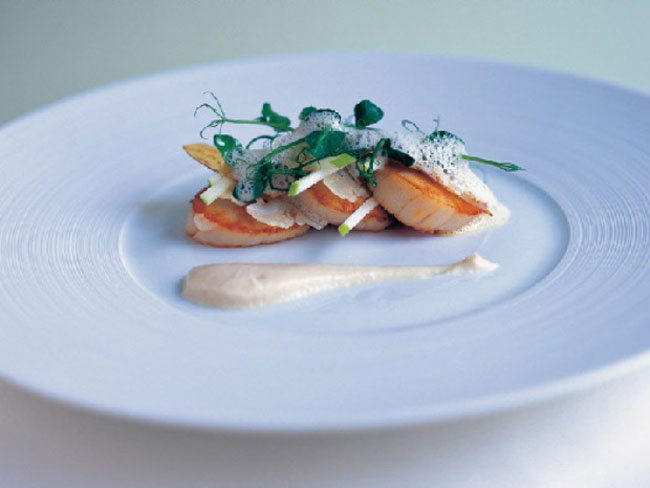
Image: pinterest.com
A side effect of the slow eating is that your guests are actually giving their stomachs and brains time to feel the food fill them. If you don’t want everyone to be uncomfortably stuffed instead of contentedly satiated, be sure to control those portion sizes.
.
Bread
Oh dear, don’t ever forget the bread! Any respectable French meal will have bread… and it’s so delicious, how could you omit it?!
The French can be pretty particular about their bread though. For example, did you know it’s an insult to place a baguette on the table upside down? Yep, if you do that you’re insulting the host, the cooking, and the whole country!
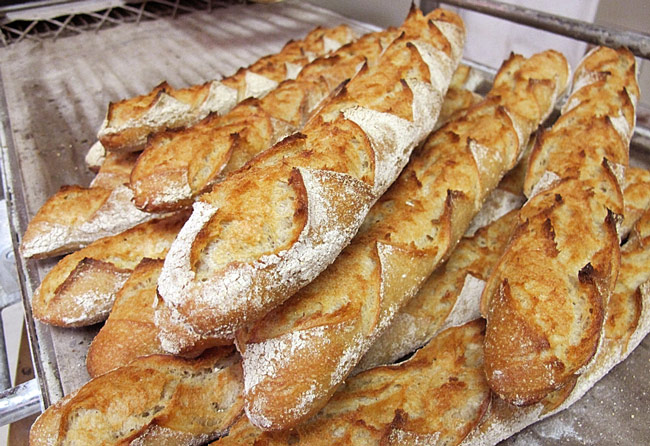
Image: raidspatisserie.fr
Let’s avoid those faux-pas, shall we? Here are some tips on bread.
To rip, or to cut: Generally at a casual dinner between family, a whole baguette will be placed on the table and everyone will rip of what they’d like during the course of the meal. In more formal dinners or ones with guests, a baguette is pre-sliced into rounds and put into a basket on the table. Often with nicer dinners, a heartier country bread loaf is offered along with the regular or ‘tradition’ baguette.
Bread choice: In Paris, wonderful bakeries are around nearly every corner. You may not be able to find those crackling crusty perfect French baguettes where you live, though. I know from experience that a French baguette bought in a Chicago grocery store, though tasty, is a quite different beast than what I purchase from my bakery in Paris’ Montmartre district. When I’m home, I prefer hearty loaves like sourdough or rye as more flavorful options, personally. But any kind of bread is a necessary edition to a French dinner!
How much bread: Don’t forget that you should have enough for the meal, and the cheese course. You may want to get more bread than you think you’ll need – try 1 baguette for every 2-3 guests (a baguette in France is 300grams, so if you have a smaller or larger one then adjust accordingly!).
If you have extra bread after the meal, you can always do as the French do and make pain perdu the next morning for breakfast. And what’s that? French toast, of course!
.
Consider simple wine pairings
If you really want to get in-depth, pair your wines to what you’re eating. There’s a lot of viniculture hocus-pocus that can make wine pairing seem like magic. However, here some few very simple tips to consider!
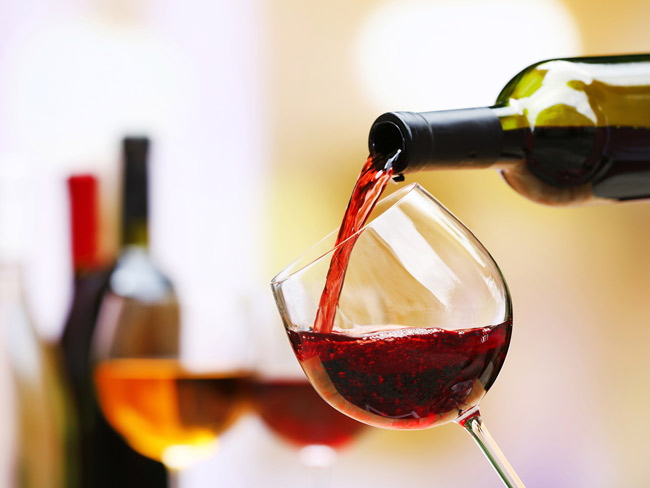
Image: vignette.wiki.anocookie.com
- Start with champagne – Champagne, according to a French sommelier I know, pairs perfectly with everything. Most people don’t see serving champagne through an entire meal though, so let’s just say it’s a great aperitif, or a fun bubbly way to complement your starter.
- Fatty/ fatty protein dishes like steak, foie gras, duck, lamb, salmon – Pair with a wine that has slightly higher acidity, or a higher alcohol content. What you’re trying to do is complement the way that fatty foods and drinks tend to stay in your mouth. Tannic wines are also a great complement to textured fatty foods. Watch the salt content of the dishes you serve with acidic wine however, since salty + acid can be a bit much on the Tastebuds.
- Heavy foods like a casserole – Look for a wine described as full-bodied. Note that it’s not necessarily a red you’re looking for… a full-bodied white would match better with a heavy meat dish than a light-bodied red.
- Salty foods – Complement the dish by a hint of sweetness (though don’t go so far as to serve a dessert wine with ham!). Stay away from very dry wines.
- Lighter dishes like fish or chicken – Look for a wine that’s described as delicate, balanced, elegant, or buttery. The point is, you don’t want to overpower the flavor! White wine is usually chosen for this, though a low-tannin red would also be great.
- Acidic dishes like vinaigrette salad or lemon sauce – Choose an acidic wine to match. Otherwise, the wine will taste a bit flat.
- Cheeses – The assumption is that red wine is the best (and it is a great choice!). However, a sweeter wine will balance the salt so makes a great companion to a cheese plate.
- Sweet dishes – Higher acidity or bitter/tannic wine balances the sweetness quite well.
You can definitely see how you could actually serve a different wine with each course! If you’d just prefer to stick to one wine for the meal, choose one that will complement with your main dish.
It’s always best to let the wine breathe before you serve it – an hour is typically the minimum. For a young wine, closer to 3 hours is better. Simply uncork the bottle(s) and set it aside… you don’t need to decant or aerate it, though this can help speed up that breathing process. You’d be surprised at how striking the change can be after letting wine breathe!
.
THE AMBIANCE
Add a French touch to your table settings
Generally French table settings are pretty low-fuss, natural, rustic, and seemingly effortless. Does that sound like a pretty difficult bill to fill?
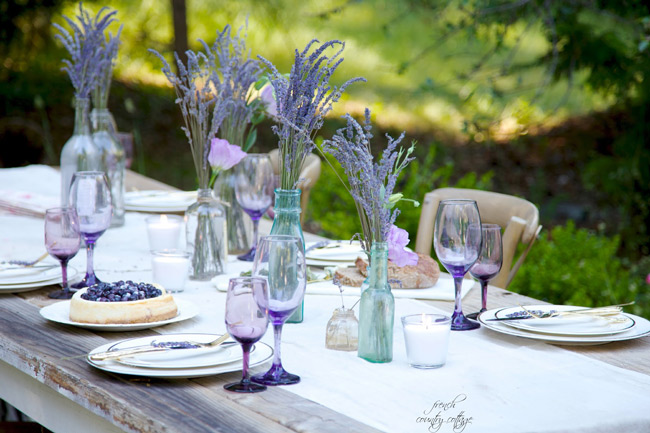
Image: frenchcountrycottage.com
Here are a handful of tips to un-complicate this for you:
- Don’t worry about having matching China. Many Parisians have a hodge podge of serving plates, platters, serving utensils etc, that they’ve found at the flea market.
- Same goes for your glasses! They don’t have to be matching – however, stemmed glasses (even for water) are pretty typical in a traditional French dinner party. Whatever you’re drinking will stay at its temperature for longer, without your warm hands grabbing the glass.
- Use cloth napkins. From Etsy to your favorite department store to garage sales, these are everywhere (if you’re looking for them). The French very rarely use disposable napkins.
- Choose an old linen sheet as a tablecloth – it gives that rustic chic feel to the table.
- Keep glass carafes of water on the table so guests can stay hydrated
- Use fleur de sel in small bowls, instead of table salt shakers. The French absolutely love the crunchy and flavorful salt as a finishing touch.
- Count on about 25-30in between each setting if you can, to make sure everyone has enough room to be comfortable
- Centerpieces – understated is quite French, so a casual floral arrangement or handpicked garden flowers is perfect. Another great natural look is olive tree branches or other faded greens
- Don’t crowd your table too much with flowers or candles (though everyone does look fabulous in candlelight!). Think, “Less is More”.
- Jacques Brel
- Carla Bruni
- Serge Gainsbourg
- Johnny Hallyday
- George Brassens
- Jacques Dutronc
- Edith Piaf
- Zaz
- Camille
- Olivia Ruiz
- -M-
- Cœur de Pirate
- Amélie movie score (composer: Yann Tiersen)
- Midnight in Paris score
- Search “best French music” on Google and take a look at the video playlist options
- Search for French playlists on Spotify, Pandora, or Deezer
.
Don’t forget the music
Setting the ambiance also means having that background music to match the occasion! After all, your meal is going to be so delicious that there are sure to be silent moments, when your guests have their mouths full…
Here are some recommended music choices, from French classics to modern favorites:
.
Drink suggestions
Do you want your dinner party to last all night?
Or maybe you’re not interested in hosting a dinner at all, but just having a cocktail party?
Either way, you can’t go wrong with any of these fabulous French drinks.

Image: femmeactuel.fr

While in Melbourne lockdown we are having theme dinner parties on zoom with groups of friends so looking forward to using some of your ideas THANK YOU
We hope you were able to! Stay safe!
nice information shared.
Awesome content!!!
I will use many if your tips during my super club dinner I’m hosting this month which is French themed!!!
Thank you
Kelly
Thanks for reading Kelly! Have an awesome dinner party 🙂
Thank you so much for this very helpful information.
We are a group of friends doing our own MKR and my husband and I have decided to go with a French theme. I am planning to do a Beef bourguignon. Do you have any ideas on how to plate this to look more like ‘fine dining’?
I was going to make some mashed potatoes, but now thinking of doing potato stacks. Any thoughts? 🙂
Bonjour Sophia, thanks for reading! We’re so happy you’re going to try to have a French themed party! Our advice for the boeuf bourguignon would be to make sure you have some nice china and a special serving spoon to make it look more like fine dining 🙂 A beautiful table setting helps too! Potato stacks sound like a wonderful idea 🙂
I found it interesting that you state that French food is delivered one course at a time. My wife is hosting a large book club party and wants to have real French cuisine on the menu. I will send her this information so she can find an authentic French restaurant that can cater and make sure the meal is split into courses.
We’re happy we can help, Benjamin! Good luck to your wife for her book club party 🙂